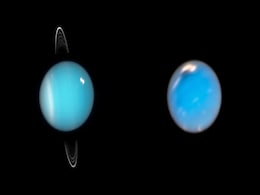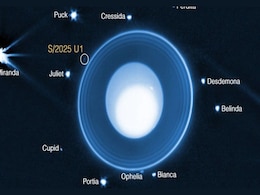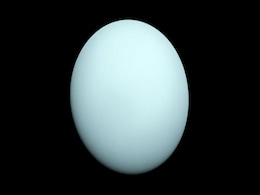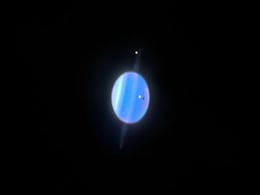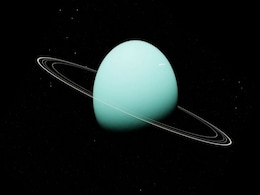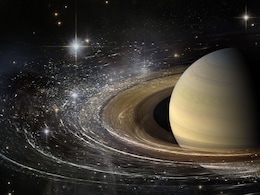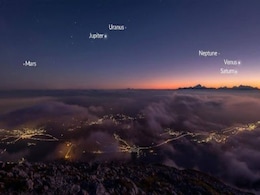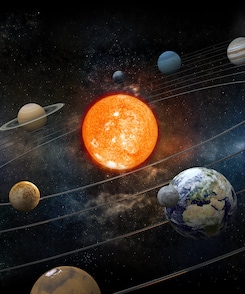Uranus
- All
- News
- Videos
- Web Stories
-

Uranus and Neptune May Be Rock-Dominated Planets, Study Suggests
- Saturday December 13, 2025
- Written by Gadgets 360 Staff
Uranus and Neptune may not be true ice giants after all. New research using advanced hybrid simulations suggests the distant planets could be dominated by rocky material rather than water-rich ices. The findings challenge decades of planetary models and may help explain the planets’ unusual, non-dipolar magnetic fields. Scientists say future dedi...
-
 www.gadgets360.com
www.gadgets360.com
-

Uranus and Neptune May Be Rocky Worlds Not Ice Giants, New Research Shows
- Thursday December 11, 2025
- Written by Gadgets 360 Staff
A new analysis challenges decades-old assumptions about Uranus and Neptune, revealing that both planets may contain far more rock than icy materials. These findings help explain their strange magnetic fields and show that traditional "ice giant" models may be incomplete. Scientists say only dedicated future missions can uncover the true interior ma...
-
 www.gadgets360.com
www.gadgets360.com
-

From Meteor Showers To Beaver Supermoon, 10 Must-See Celestial Events In November 2025
- Wednesday November 5, 2025
- Science | Edited by Ritu Singh
November skygazing events: The month begins with the Taurid meteor showers, known for producing slow, bright fireballs that light up the sky.
-
 www.ndtv.com
www.ndtv.com
-

Uranus and Neptune May Be More Rock Than Ice, New Research Suggests
- Wednesday October 15, 2025
- Written by Gadgets 360 Staff
A new pre-print study proposes that Uranus and Neptune might not be “ice giants” after all. Using assumption-free models, scientists found their interiors could range from mostly icy to mostly rocky, suggesting we know far less about these distant worlds and that new missions are essential to solve the mystery.
-
 www.gadgets360.com
www.gadgets360.com
-

Indian Billboard Goes Viral For Elon Musk, Uranus Wordplay, Internet Calls It 'Hilarious'
- Monday September 1, 2025
- Offbeat | Edited by Abhinav Singh
A billboard advertising a wellness clinic in India has gone viral for cleverly incorporating Elon Musk's idea of Mars colonisation and gut health.
-
 www.ndtv.com
www.ndtv.com
-

James Webb Telescope Discovers Tiny New Moon Orbiting Uranus
- Saturday August 23, 2025
- Written by Gadgets 360 Staff
A team from the Southwest Research Institute has discovered a tiny new moon orbiting Uranus using NASA’s James Webb Space Telescope. The moon, called S/2025 U1, is just 6 miles (10 kilometers) wide, too small for Voyager 2 to detect during its 1986 flyby. This discovery brings Uranus’s total known moons to 29, with S/2025 U1 orbiting 35,000 mil...
-
 www.gadgets360.com
www.gadgets360.com
-

Uranus Found Emitting Internal Heat, Reviving Hopes for Flagship NASA Mission
- Thursday July 17, 2025
- Written by Gadgets 360 Staff
Astronomers have discovered that Uranus emits 12% more heat than it receives from sunlight, contradicting past data from Voyager 2. The internal warmth likely comes from leftover energy in the planet’s core, offering clues to its tilt and interior structure. This unexpected heat has intensified calls for a flagship NASA mission to Uranus. Scienti...
-
 www.gadgets360.com
www.gadgets360.com
-

Hubble Finds Cosmic Dust Coating Uranus’ Moons, Not Radiation Scars
- Thursday June 12, 2025
- Written by Gadgets 360 Staff
New Hubble Space Telescope observations have upended decades of expectations about Uranus’ moons. Scientists once thought the planet’s magnetic field darkened their backsides with radiation, but the latest data shows Titania and Oberon are collecting space dust on their leading sides instead. This “cosmic bug splatter” effect suggests dust ...
-
 www.gadgets360.com
www.gadgets360.com
-

NASA Observes Rare Uranus Occultation, Unveiling New Atmospheric and Ring Details
- Tuesday April 29, 2025
- Written by Gadgets 360 Staff
NASA captured a rare stellar occultation of Uranus this month, providing fresh data about the ice giant’s atmosphere and rings. Scientists measured temperature changes and atmospheric composition, offering new insights since the last major occultation in 1996. The findings could help guide future exploration missions and deepen our understanding ...
-
 www.gadgets360.com
www.gadgets360.com
-

Scientists Finally Discover How Long a Day Lasts on Uranus
- Saturday April 12, 2025
- Written by Gadgets 360 Staff
Astronomers confirm Uranus’ rotation period using internal oscillation modeling for the first time. On Uranus, a day just lasts far longer. More precise rotational time observations of the gas giant should enable scientists to plan visits to investigate it. Unlike on Mars and Earth, savage windstorms make it far more difficult to identify the rot...
-
 www.gadgets360.com
www.gadgets360.com
-

Saturn Becomes Undisputed 'Moon King' Of Solar System With Discovery Of 128 New Satellites
- Monday March 17, 2025
- Science | Edited by Abhinav Singh
With the new spottings, Saturn has usurped Jupiter which has 95 known moons, while Uranus (28) and Neptune (16) remain third and fourth on the list.
-
 www.ndtv.com
www.ndtv.com
-

A Fourth 'Mysterious' Form Of Water That Could Form On Alien Planets Observed
- Saturday March 8, 2025
- Science | Edited by Abhinav Singh
Even the icy planets in our solar system such as Neptune, Uranus or Jupiter's moon Europa, might have harboured plastic ice VII.
-
 www.ndtv.com
www.ndtv.com
-

Rare Seven-Planet Alignment 2025: How to Watch in India, Best Viewing Tips
- Monday February 24, 2025
- Written by Gadgets 360 Staff
A rare celestial event featuring seven planets—Mercury, Venus, Mars, Jupiter, Saturn, Uranus, and Neptune—aligning along the ecliptic will be visible in 2025. The alignment starts on February 28, with the best viewing in India on March 3. Venus and Jupiter will be easily visible, while Uranus and Neptune will require a telescope. Experts sugges...
-
 www.gadgets360.com
www.gadgets360.com
-

February 2025 Planet Parade: How to See Five Planets Align in the Sky
- Wednesday February 5, 2025
- Written by Gadgets 360 Staff
A rare celestial event will unfold in February 2025, with five bright planets—Venus, Jupiter, Mars, Mercury, and Saturn—visible in the evening sky. The highlight occurs on February 24, when Mercury and Saturn appear closest. Uranus and Neptune can also be observed with telescopes. Best viewing conditions require a clear west-southwest horizon a...
-
 www.gadgets360.com
www.gadgets360.com
-

Uranus and Neptune May Be Rock-Dominated Planets, Study Suggests
- Saturday December 13, 2025
- Written by Gadgets 360 Staff
Uranus and Neptune may not be true ice giants after all. New research using advanced hybrid simulations suggests the distant planets could be dominated by rocky material rather than water-rich ices. The findings challenge decades of planetary models and may help explain the planets’ unusual, non-dipolar magnetic fields. Scientists say future dedi...
-
 www.gadgets360.com
www.gadgets360.com
-

Uranus and Neptune May Be Rocky Worlds Not Ice Giants, New Research Shows
- Thursday December 11, 2025
- Written by Gadgets 360 Staff
A new analysis challenges decades-old assumptions about Uranus and Neptune, revealing that both planets may contain far more rock than icy materials. These findings help explain their strange magnetic fields and show that traditional "ice giant" models may be incomplete. Scientists say only dedicated future missions can uncover the true interior ma...
-
 www.gadgets360.com
www.gadgets360.com
-

From Meteor Showers To Beaver Supermoon, 10 Must-See Celestial Events In November 2025
- Wednesday November 5, 2025
- Science | Edited by Ritu Singh
November skygazing events: The month begins with the Taurid meteor showers, known for producing slow, bright fireballs that light up the sky.
-
 www.ndtv.com
www.ndtv.com
-

Uranus and Neptune May Be More Rock Than Ice, New Research Suggests
- Wednesday October 15, 2025
- Written by Gadgets 360 Staff
A new pre-print study proposes that Uranus and Neptune might not be “ice giants” after all. Using assumption-free models, scientists found their interiors could range from mostly icy to mostly rocky, suggesting we know far less about these distant worlds and that new missions are essential to solve the mystery.
-
 www.gadgets360.com
www.gadgets360.com
-

Indian Billboard Goes Viral For Elon Musk, Uranus Wordplay, Internet Calls It 'Hilarious'
- Monday September 1, 2025
- Offbeat | Edited by Abhinav Singh
A billboard advertising a wellness clinic in India has gone viral for cleverly incorporating Elon Musk's idea of Mars colonisation and gut health.
-
 www.ndtv.com
www.ndtv.com
-

James Webb Telescope Discovers Tiny New Moon Orbiting Uranus
- Saturday August 23, 2025
- Written by Gadgets 360 Staff
A team from the Southwest Research Institute has discovered a tiny new moon orbiting Uranus using NASA’s James Webb Space Telescope. The moon, called S/2025 U1, is just 6 miles (10 kilometers) wide, too small for Voyager 2 to detect during its 1986 flyby. This discovery brings Uranus’s total known moons to 29, with S/2025 U1 orbiting 35,000 mil...
-
 www.gadgets360.com
www.gadgets360.com
-

Uranus Found Emitting Internal Heat, Reviving Hopes for Flagship NASA Mission
- Thursday July 17, 2025
- Written by Gadgets 360 Staff
Astronomers have discovered that Uranus emits 12% more heat than it receives from sunlight, contradicting past data from Voyager 2. The internal warmth likely comes from leftover energy in the planet’s core, offering clues to its tilt and interior structure. This unexpected heat has intensified calls for a flagship NASA mission to Uranus. Scienti...
-
 www.gadgets360.com
www.gadgets360.com
-

Hubble Finds Cosmic Dust Coating Uranus’ Moons, Not Radiation Scars
- Thursday June 12, 2025
- Written by Gadgets 360 Staff
New Hubble Space Telescope observations have upended decades of expectations about Uranus’ moons. Scientists once thought the planet’s magnetic field darkened their backsides with radiation, but the latest data shows Titania and Oberon are collecting space dust on their leading sides instead. This “cosmic bug splatter” effect suggests dust ...
-
 www.gadgets360.com
www.gadgets360.com
-

NASA Observes Rare Uranus Occultation, Unveiling New Atmospheric and Ring Details
- Tuesday April 29, 2025
- Written by Gadgets 360 Staff
NASA captured a rare stellar occultation of Uranus this month, providing fresh data about the ice giant’s atmosphere and rings. Scientists measured temperature changes and atmospheric composition, offering new insights since the last major occultation in 1996. The findings could help guide future exploration missions and deepen our understanding ...
-
 www.gadgets360.com
www.gadgets360.com
-

Scientists Finally Discover How Long a Day Lasts on Uranus
- Saturday April 12, 2025
- Written by Gadgets 360 Staff
Astronomers confirm Uranus’ rotation period using internal oscillation modeling for the first time. On Uranus, a day just lasts far longer. More precise rotational time observations of the gas giant should enable scientists to plan visits to investigate it. Unlike on Mars and Earth, savage windstorms make it far more difficult to identify the rot...
-
 www.gadgets360.com
www.gadgets360.com
-

Saturn Becomes Undisputed 'Moon King' Of Solar System With Discovery Of 128 New Satellites
- Monday March 17, 2025
- Science | Edited by Abhinav Singh
With the new spottings, Saturn has usurped Jupiter which has 95 known moons, while Uranus (28) and Neptune (16) remain third and fourth on the list.
-
 www.ndtv.com
www.ndtv.com
-

A Fourth 'Mysterious' Form Of Water That Could Form On Alien Planets Observed
- Saturday March 8, 2025
- Science | Edited by Abhinav Singh
Even the icy planets in our solar system such as Neptune, Uranus or Jupiter's moon Europa, might have harboured plastic ice VII.
-
 www.ndtv.com
www.ndtv.com
-

Rare Seven-Planet Alignment 2025: How to Watch in India, Best Viewing Tips
- Monday February 24, 2025
- Written by Gadgets 360 Staff
A rare celestial event featuring seven planets—Mercury, Venus, Mars, Jupiter, Saturn, Uranus, and Neptune—aligning along the ecliptic will be visible in 2025. The alignment starts on February 28, with the best viewing in India on March 3. Venus and Jupiter will be easily visible, while Uranus and Neptune will require a telescope. Experts sugges...
-
 www.gadgets360.com
www.gadgets360.com
-

February 2025 Planet Parade: How to See Five Planets Align in the Sky
- Wednesday February 5, 2025
- Written by Gadgets 360 Staff
A rare celestial event will unfold in February 2025, with five bright planets—Venus, Jupiter, Mars, Mercury, and Saturn—visible in the evening sky. The highlight occurs on February 24, when Mercury and Saturn appear closest. Uranus and Neptune can also be observed with telescopes. Best viewing conditions require a clear west-southwest horizon a...
-
 www.gadgets360.com
www.gadgets360.com




